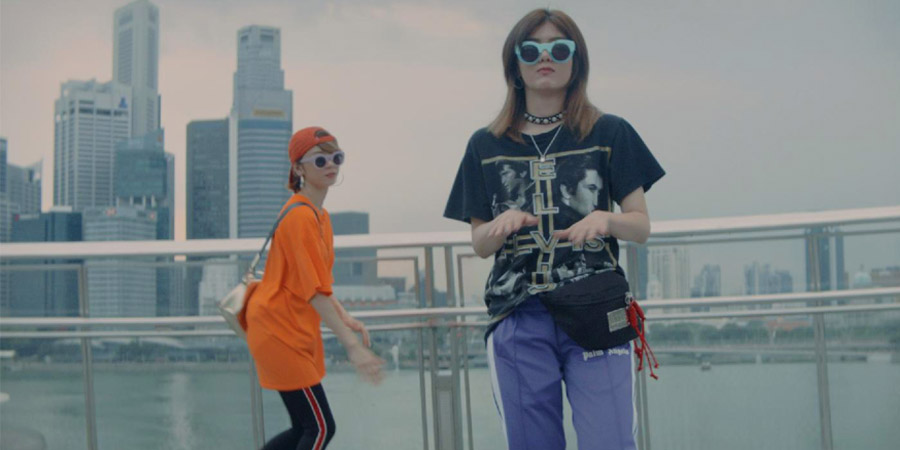If countless films are to believed, the act of travel — spending time in an unfamiliar or distant land, for business, pleasure or escape — precipitates a transformation of the self. You can shed all your duties, ride Vespas and get into bar fights for a spell. Romantic bonds can be ignited, exploded, and reshaped far from home. There’s a whole sub-genre dedicated to middle-aged suburbanites who, finding themselves alienated from the conventional trappings of the day-to-day, find self-actualisation over the border.
Even if the heroes of these pieces return (or, in the darker case of Into the Wild [2007], are condemned to the Alaskan wilderness) something fundamental has shifted. They are now worldlier, more educated in the matter of Life.
Daisuke Miyazaki’s Tourism, which follows two Japanese women undertaking a free overseas trip, both invokes and questions these supposed merits of travel. Nina (Nina Endo) and Su (Sumire) are two disaffected young roommates living in small-town Japan. As micro-influencers with an online following, they project a chicness (with branded streetwear, perfect highlights, studded ears) that contrasts their dour surroundings, marked by decidedly unfashionable parents and empty playgrounds. Like many a millennial, they struggle to pay the rent or find full-time work; they yearn for an escape, and don’t particularly care where. “I don’t want to get married and old here without doing anything,” Nina confesses. When they win a lottery to go anywhere in the world, they settle on Singapore after their roommate claims: “The whole country is like Disneyland.”
Outside the realm of film and travelogues, the rise of social media has further inflated the narrative of a life-changing, rewarding vacation. How Instagram-worthy a locale is now factors into its desirability as a holiday destination; meanwhile, social media is driving more visitors to national parks and galleries (a phenomenon Dena Yago labels the “exhibition as content farm”). Individuals have more control over public perception of their globe-trotting than ever. In dialogue with this context, cinematographer Yasutaka Watanabe seems to take visual cues from the vlogs and livestreams of popular influencers. Nina and Su amble around neon art installations and food markets; the blues and greens of their surroundings are deeply saturated, as if a VSCO filter has been fitted atop every frame. Sweeping pans of bustling shopfronts and crowds cut to front-facing smartphone footage of the women live-streaming their meals or narrating their stroll through the Orchard Gateway mall.
Miyazaki cannily replicates the feel of travel vlogs: the manufactured intimacy of hand-held personal asides exists alongside ultra-polished footage of a major city’s trendiest hotspots. All the while, the film’s spare but dryly comic script renders these visual clichés ironic. Nina and Su are deeply unmoved at everything they see. The iconic Merlion statue, Singapore’s mascot is “ smaller than I thought. Not so special.” The sprawling shopping strips are “just like Japan.” Beautiful vistas co-exist at a leisurely pace with hilarious, abject disappointment until, suddenly, Nina loses sight of Su and her phone — and is completely unmoored.
Tourism was first screened at Singapore’s ArtScience Museum, as part of the 2017 “Specters and Tourists” exhibit. The work aimed to “depict the all too familiar scene of humdrum urban life, and celebrate when unscripted and unexpected moments challenge our perception of reality.” The implication here is clear: the film’s second half — where Nina finds herself adrift in civilian neighbourhoods, the side of Singapore that doesn’t match up with the global imagination of an immaculate Disneyland — presents a more authentic Singapore than the one we saw before. Miyazaki shifts gears, dwarfing Nina in intimidating wide shots as she stumbles through unfamiliar Southeastern Asian hubs. Nina’s journey is now less mainstream, and all it took was getting off her damn phone and being taken in by a kind Malay family (who offer her lodging, invite her to a family meal and take her to an exclusive rooftop gig).
The focus on Singapore’s oft-ignored ethnic groups is admirable, but the notions of authenticity here can seem simplistic or neatly packaged. But Miyazaki manages to dodge any sense of mawkishness through the film’s truly disorienting idiosyncrasies. The camera here is curious and omniscient — oftentimes, it will pan away from the film’s protagonists and observe faces in the crowd, who openly look into the lens, or at the people behind it. Miyazaki will often cut from a point-of-view shot of the women taking a selfie, to another angle of them taking that same selfie, but this time from a far-off distance. Shadows from the crew members can often be spotted stretching across the pavement. These jarring elements generate multiple narrative strands: there’s Nina and Su’s actual journey, Nina and Su’s journey as presented in their own footage, and the filmmakers documenting the whole thing. Filmmakers who are, of course, travellers themselves.
What results is a genuinely unique film about how narratives about travel are meticulously constructed, performed, and proliferated. In one of Tourism’s most delightful non-sequiturs, Nina and Su spontaneously begin to dance on a rooftop to an electronic beat, surrounded by a panoramic waterfront. It’s ambiguous whether this is an organic moment between them: a joyous celebration of being young and abroad, or if they’re simply doing it for the ‘gram.
Tourism will be playing on 23 February as part of the Hyperlinks festival.
Visit the Hyperlinks site for more info.
**********
Claire Cao is a freelance writer and avid dumpling lover from Western Sydney. She is a member of Sweatshop: Western Sydney Literacy Movement. Her work has appeared in The Lifted Brow Review of Books, Voiceworks, SBS Life and the anthology Sweatshop Women. She tweets @clairexinwen.


